Lyons W.C. (ed.). Standard handbook of petroleum and natural gas engineering.2001- Volume 1
Подождите немного. Документ загружается.

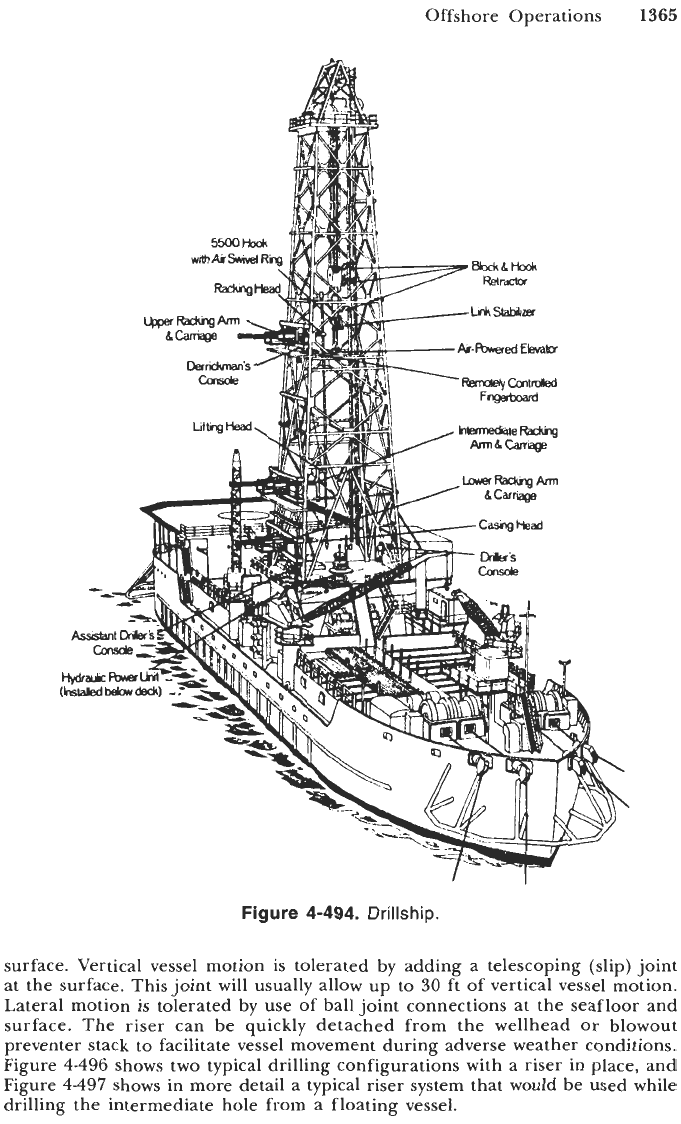
Offshore Operations
1365
Figure
4-494.
Drillship.
surface. Vertical vessel motion is tolerated by adding a telescoping (slip) joint
at the surface. This joint will usually allow up to
30
ft of vertical vessel motion.
Lateral motion is tolerated by use of ball joint connections at the seafloor and
surface. The riser can be quickly detached from the wellhead or blowout
preventer stack to facilitate vessel movement during adverse weather conditions.
Figure
4-496
shows two typical drilling configurations with a riser in place, and
Figure
4-497
shows in more detail a typical riser system that would be used while
drilling the intermediate hole from a floating vessel.
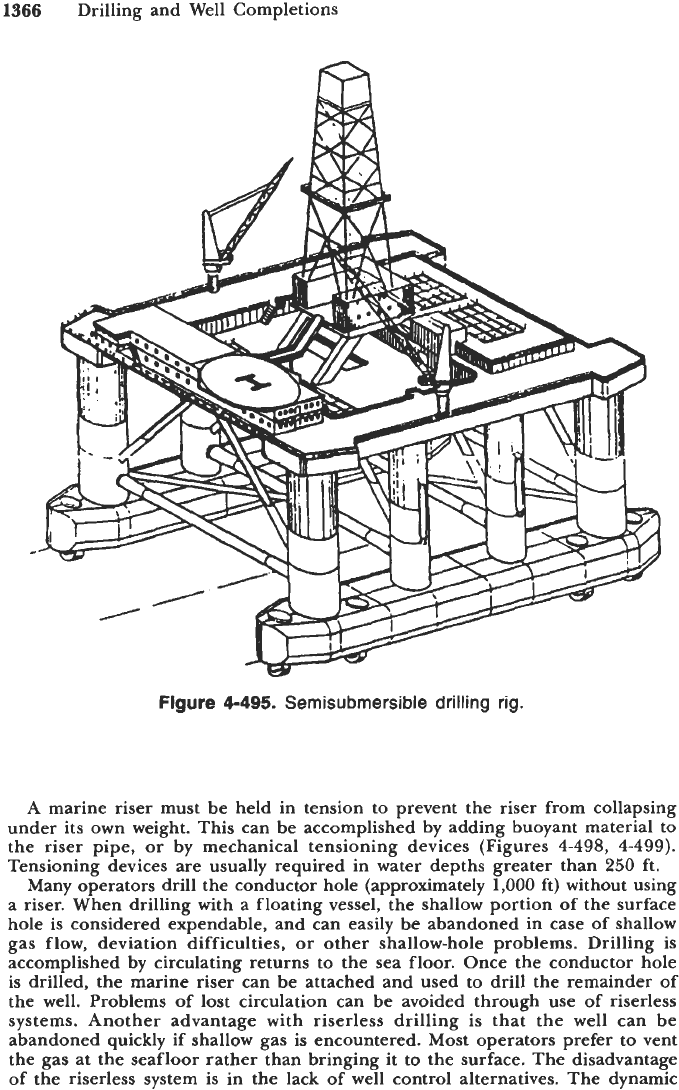
1366
Drilling and Well Completions
Figure
4-495.
Semisubmersible drilling rig.
A
marine riser must be held in tension to prevent the riser from collapsing
under its own weight. This can be accomplished by adding buoyant material to
the riser pipe,
or
by mechanical tensioning devices (Figures
4-498,
4-499).
Tensioning devices are usually required in water depths greater than
250
ft.
Many operators drill the conductor hole (approximately
1,000
ft) without using
a riser. When drilling with a floating vessel, the shallow portion of the surface
hole is considered expendable, and can easily be abandoned in case of shallow
gas flow, deviation difficulties,
or
other shallow-hole problems. Drilling is
accomplished by circulating returns to the sea floor. Once the conductor hole
is drilled, the marine riser can be attached and used to drill the remainder of
the well. Problems of lost circulation can be avoided through use of riserless
systems. Another advantage with riserless drilling is that the well can be
abandoned quickly if shallow gas
is
encountered. Most operators prefer to vent
the gas at the seafloor rather than bringing it to the surface. The disadvantage
of
the riserless system is in the lack of well control alternatives. The dynamic
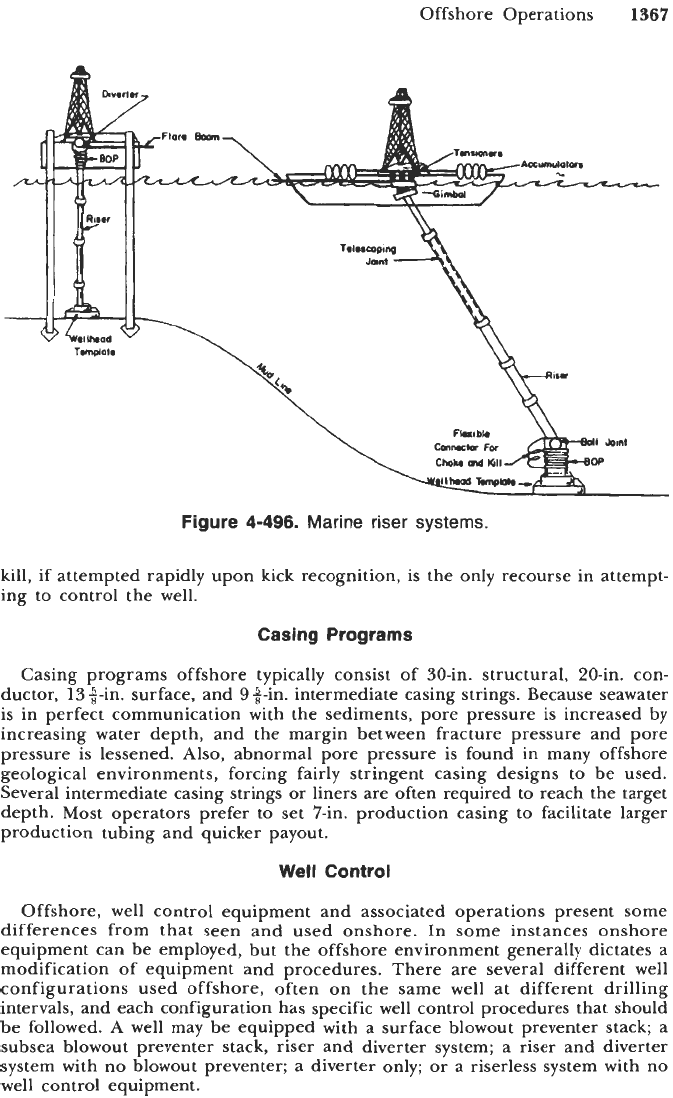
Offshore Operations
1.367
Figure
4-496.
Marine
riser
systems.
kill,
if
attempted rapidly upon kick recognition, is the only recourse in attempt-
ing to control the well.
Casing Programs
Casing programs offshore typically consist of 30-in. structural, 20-in. con-
ductor, 13 Q-in. surface, and
9
$-in. intermediate casing strings. Because seawater
is in perfect communication with the sediments, pore pressure
is
increased by
increasing water depth, and the margin between fracture pressure and pore
pressure is lessened.
Also,
abnormal pore pressure is found in many offshore
geological environments, forcing fairly stringent casing designs to be used.
Several intermediate casing strings or liners are often required to reach the target
depth. Most operators prefer to set 7-in. production casing
to
facilitate larger
production tubing and quicker payout.
Well
Control
Offshore, well control equipment and associated operations present some
differences from that seen and used onshore.
In
some instances onshore
equipment can be employed, hut the offshore environment generally dictates a
modification of equipment and procedures. There are several different well
configurations used offshore, often on the same well at different drilling
intervals, and each configuration has specific well control procedures that should
be followed.
A
well may be equipped with a surface blowout preventer stack; a
subsea blowout preventer stack, riser and diverter system; a riser and diverter
system with no blowout preventer; a diverter only;
or
a riserless system with no
well control equipment.
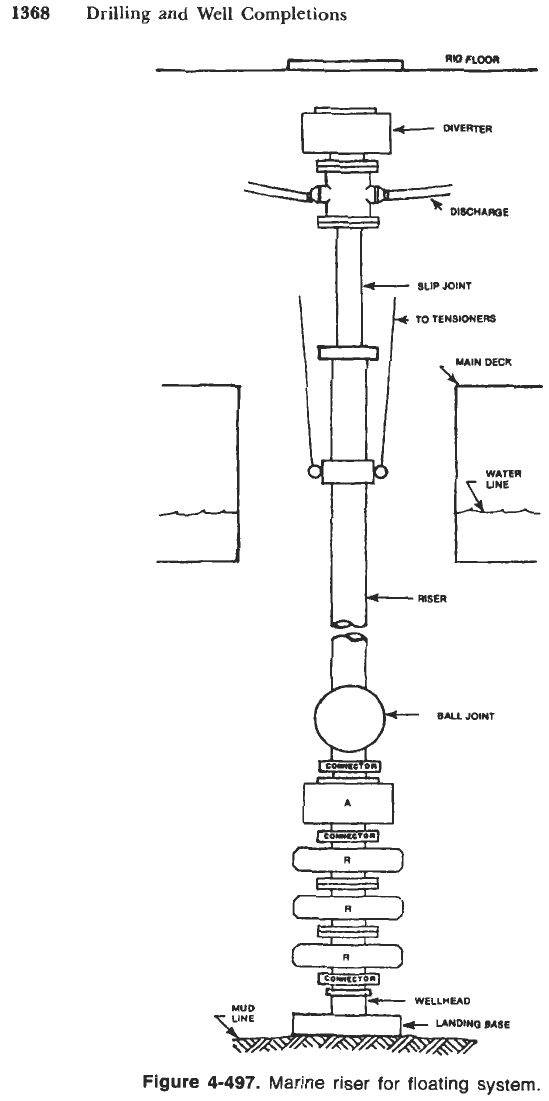
1368
Drilling
and
Well Completions
e
SLIPJOINT
TO TENSIONERS
Figure
4-497.
Marine riser for floating
system.
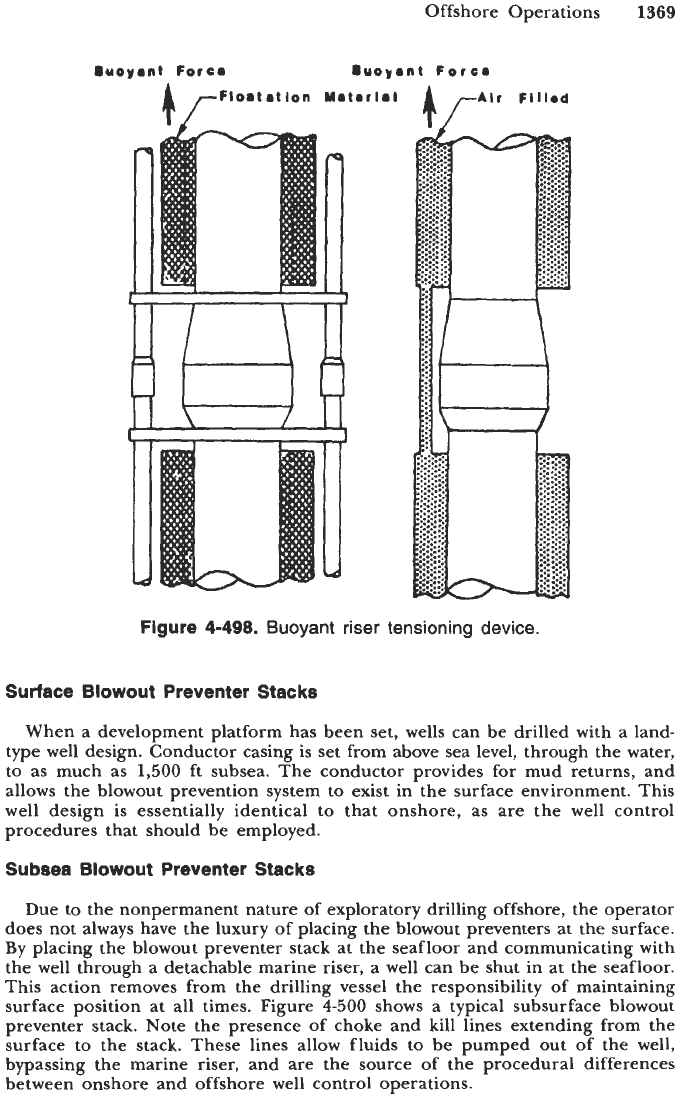
Buoyant
Forcr
Offshore Operations
1369
Buolant
Forco
Figure
4-498.
Buoyant
riser
tensioning device.
Surface Blowout Preventer Stacks
When a development platform has been set, wells can be drilled with a land-
type well design. Conductor casing is set from above sea level, through the water,
to as much as
1,500
ft subsea. The conductor provides for mud returns, and
allows the blowout prevention system to exist in the surface environment. This
well design is essentially identical to that onshore, as are the well control
procedures that should be employed.
Subsea Blowout Preventer Stacks
Due to the nonpermanent nature of exploratory drilling offshore, the operator
does not always have the luxury
of
placing the blowout preventers at the surface.
By placing the blowout preventer stack at the seafloor and communicating with
the well through a detachable marine riser, a well can be shut in at the seafloor.
This action removes from the drilling vessel the responsibility
of
maintaining
surface position at all times. Figure
4-500
shows
a
typical subsurface blowout
preventer stack. Note the presence of choke and kill lines extending from the
surface to the stack. These lines allow fluids to be pumped out of the well,
bypassing the marine riser, and are the source of the procedural differences
between onshore and offshore well control operations.
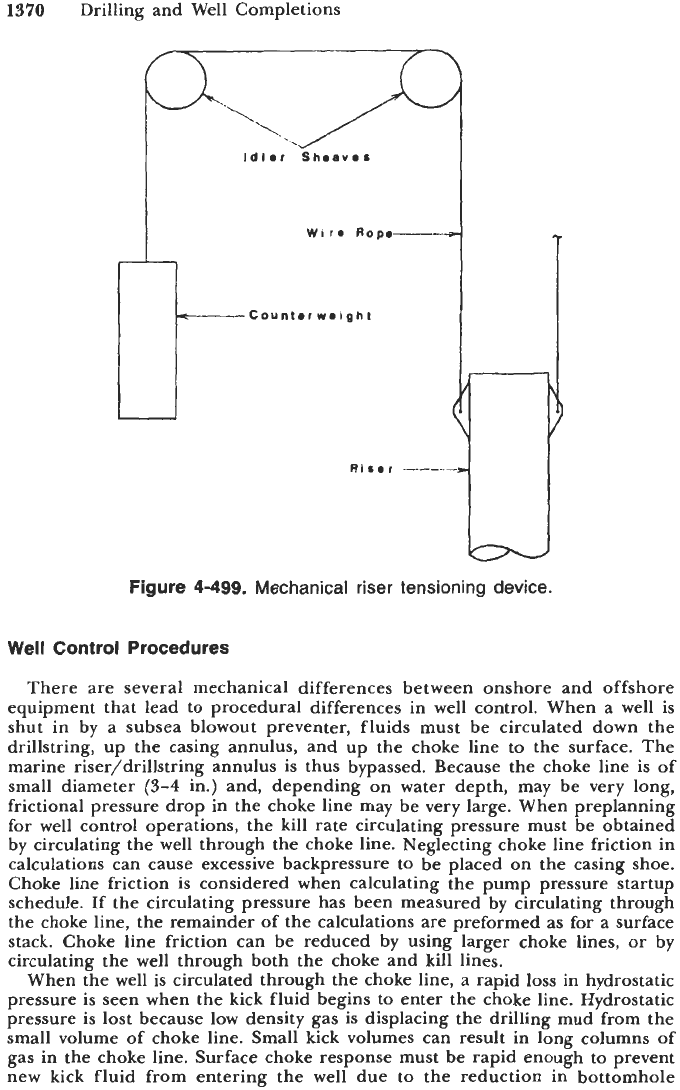
1370
Drilling and Well Completions
Figure
4-499.
Mechanical riser tensioning device.
Well
Control
Procedures
There are several mechanical differences between onshore and offshore
equipment that lead to procedural differences in well control. When a well is
shut in by a subsea blowout preventer, fluids must be circulated down the
drillstring, up the casing annulus, and up the choke line to the surface. The
marine riser/drillstring annulus is thus bypassed. Because the choke line is of
small diameter
(3-4
in.) and, depending on water depth, may be very long,
frictional pressure drop in the choke line may be very large. When preplanning
for well control operations, the kill rate circulating pressure must be obtained
by circulating the well through the choke line. Neglecting choke line friction in
calculations can cause excessive backpressure to be placed on the casing shoe.
Choke line friction is considered when calculating the pump pressure startup
schedule.
If
the circulating pressure has been measured by circulating through
the choke line, the remainder
of
the calculations are preformed as for a surface
stack. Choke line friction can be reduced by using larger choke lines, or by
circulating the well through both the choke and kill lines.
When the well is circulated through the choke line, a rapid loss in hydrostatic
pressure is seen when the kick fluid begins to enter the choke line. Hydrostatic
pressure is lost because low density gas is displacing the drilling mud from the
small volume of choke line. Small kick volumes can result in long columns
of
gas in the choke line. Surface choke response must be rapid enough to prevent
new kick fluid from entering the well due to the reduction in bottomhole
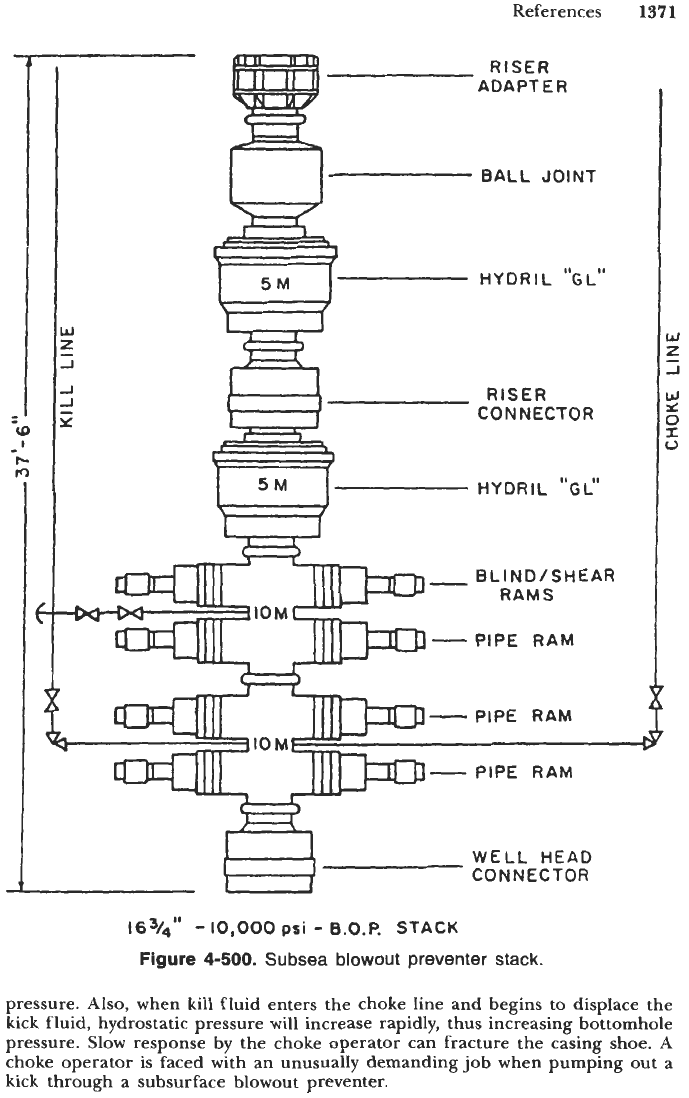
References
1371
RISER
ADAPTER
BALL
JOINT
HYORIL
"GL"
RISER
CONNECTOR
HY
OR
I
L
"G
<'
BLIND/SHE
RAMS
PIPE RAM
AR
PIPE RAM
PIPE RAM
WELL
HEAD
CONNECTOR
1634''
-
10,000
psi
-
B.O.P. STACK
Figure
4-500.
Subsea
blowout
preventer
stack.
w
J
W
Y
0
I
0
z
pressure. Also, when kill fluid enters the choke line and begins to displace the
kick fluid, hydrostatic pressure will increase rapidly, thus increasing bottomhole
pressure. Slow response by the choke operator can fracture the casing shoe.
A
choke operator
is
faced with an unusually demanding job when pumping out a
kick through a subsurface blowout preventer.
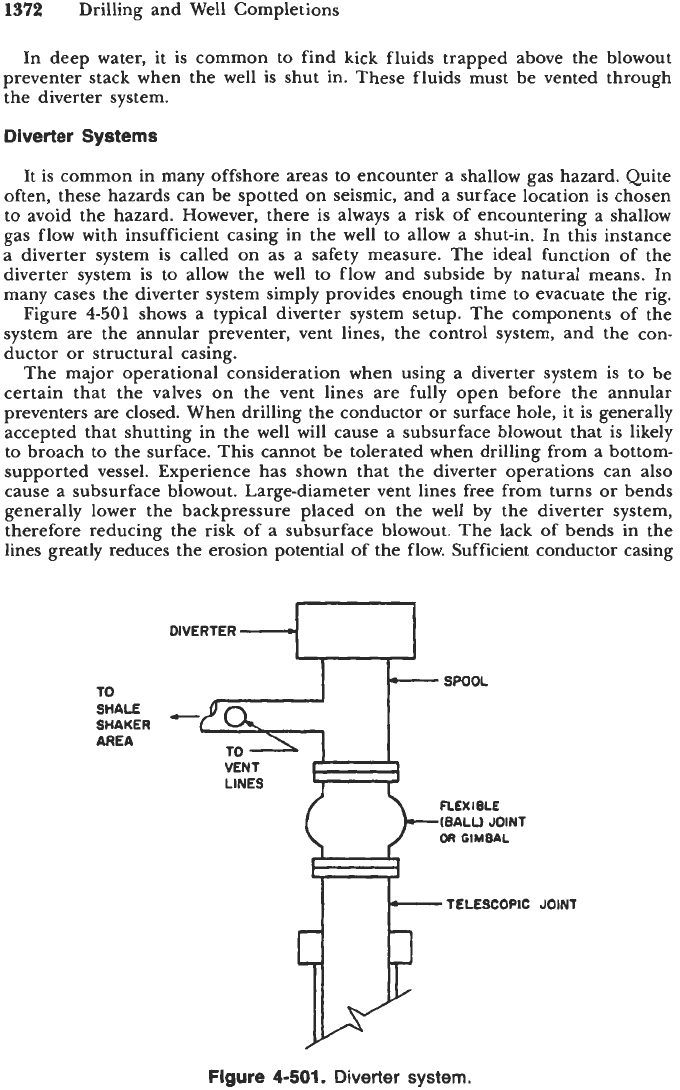
1372
Drilling and Well Completions
In deep water, it is common
to
find kick fluids trapped above the blowout
preventer stack when the well is shut in. These fluids must be vented through
the diverter system.
Diverter
Systems
It
is
common in many offshore areas to encounter a shallow gas hazard. Quite
often, these hazards can be spotted on seismic, and a surface location
is
chosen
to avoid the hazard. However, there is always a risk of encountering a shallow
gas flow with insufficient casing in the well to allow a shut-in. In this instance
a diverter system is called on as a safety measure. The ideal function of the
diverter system is to allow the well to flow and subside by natural means.
In
many cases the diverter system simply provides enough time to evacuate the rig.
Figure
4-501
shows
a
typical diverter system setup. The components of the
system are the annular preventer, vent lines, the control system, and the con-
ductor
or
structural casing.
The major operational consideration when using a diverter system is to be
certain that the valves
on
the vent lines are fully open before the annular
preventers are closed. When drilling the conductor or surface hole, it is generally
accepted that shutting in the well will cause a subsurface blowout that is likely
to broach
to
the surface. This cannot be tolerated when drilling from a bottom-
supported vessel. Experience has shown that the diverter operations can also
cause a subsurface blowout. Large-diameter vent lines free from turns
or
bends
generally lower the backpressure placed on the well by the diverter system,
therefore reducing the risk of a subsurface blowout. The lack of bends in the
lines greatly reduces the erosion potential of the flow. Sufficient conductor casing
SPOOL
TO
AREA
TO
VENT
LINES
FLEXIBLE
(BALU JOINT
OR
GIMBAL
TELESCOPIC
Flgure
4-501.
Diverter
system.
JOINT
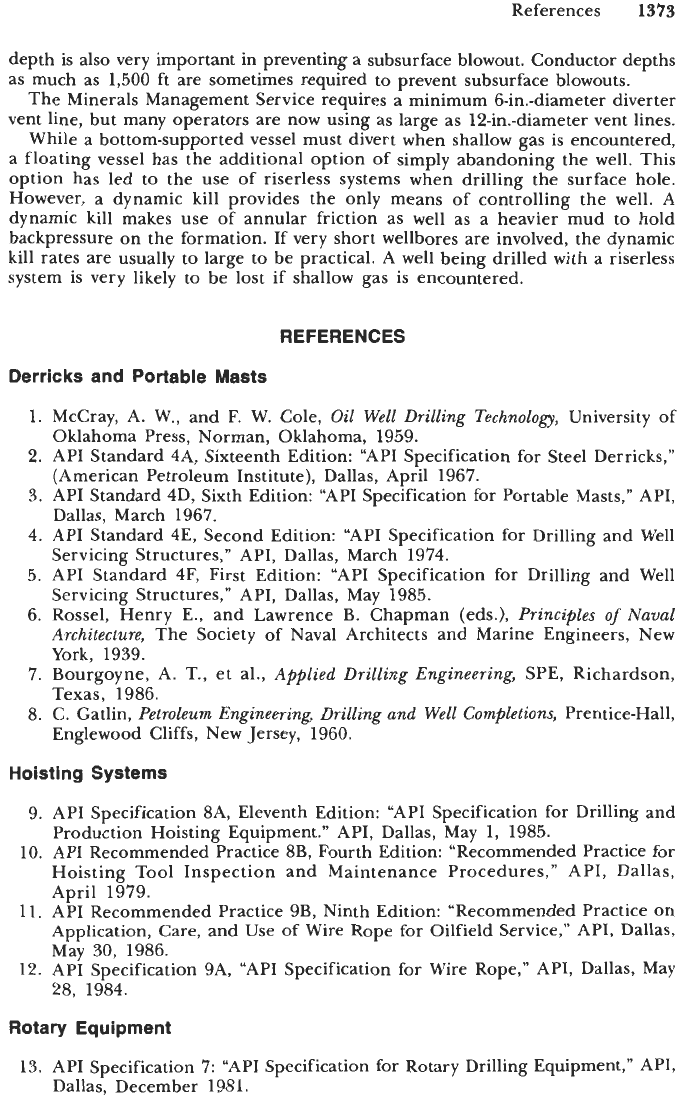
References
1373
depth is also very important in preventing a subsurface blowout. Conductor depths
as much as 1,500 ft are sometimes required to prevent subsurface blowouts.
The Minerals Management Service requires a minimum 6-in.-diameter diverter
vent line, but many operators are now using as large as 12-in.-diameter vent lines.
While a bottom-supported vessel must divert when shallow gas is encountered,
a floating vessel has the additional option of simply abandoning the well. This
option has led to the use of riserless systems when drilling the surface hole.
However, a dynamic kill provides the only means of controlling the well.
A
dynamic kill makes use of annular friction as well as a heavier mud to hold
backpressure on the formation. If very short wellbores are involved, the dynamic
kill
rates are usually to large to be practical.
A
well being drilled with a riserless
system
is
very likely to be lost if shallow gas is encountered.
REFERENCES
Derricks and Portable Masts
1.
2.
3.
4.
5.
6.
7.
8.
McCray,
A.
W., and F. W. Cole,
Oil Well Drilling Technology,
University
of
Oklahoma Press, Norman, Oklahoma, 1959.
API Standard 4A, Sixteenth Edition: “API Specification for Steel Derricks,”
(American Petroleum Institute), Dallas, April 1967.
API Standard 4D, Sixth Edition: “API Specification for Portable Masts,” API,
Dallas, March 1967.
API Standard 4E, Second Edition: “API Specification for Drilling and Well
Servicing Structures,” API, Dallas, March 1974.
API Standard 4F, First Edition: “API Specification for Drilling and Well
Servicing Structures,” API, Dallas, May 1985.
Rossel, Henry
E.,
and Lawrence B. Chapman (eds.),
Principles
of
Naval
Architecture,
The Society of Naval Architects and Marine Engineers, New
York, 1939.
Bourgoyne, A. T., et al.,
Applied Drilling Engineering,
SPE, Richardson,
Texas, 1986.
C. Gatlin,
Petroleum Engineering, Drilling and Well Completions,
Prentice-Hall,
Englewood Cliffs, New Jersey, 1960.
Hoisting Systems
9. API Specification 8A, Eleventh Edition: “API Specification for Drilling and
Production Hoisting Equipment.” API, Dallas, May 1, 1985.
10. API Recommended Practice 8B, Fourth Edition: “Recommended Practice
for
Hoisting Tool Inspection and Maintenance Procedures,” API, Dallas,
April 1979.
11. API Recommended Practice 9B, Ninth Edition: “Recommended Practice on
Application, Care, and Use of Wire Rope for Oilfield Service,” API, Dallas,
May 30, 1986.
12. API Specification 9A, “API Specification for Wire Rope,” API, Dallas, May
28.
1984.
Rotary Equipment
13. API Specification 7: “API Specification for Rotary Drilling Equipment,” API,
Dallas, December 1981.
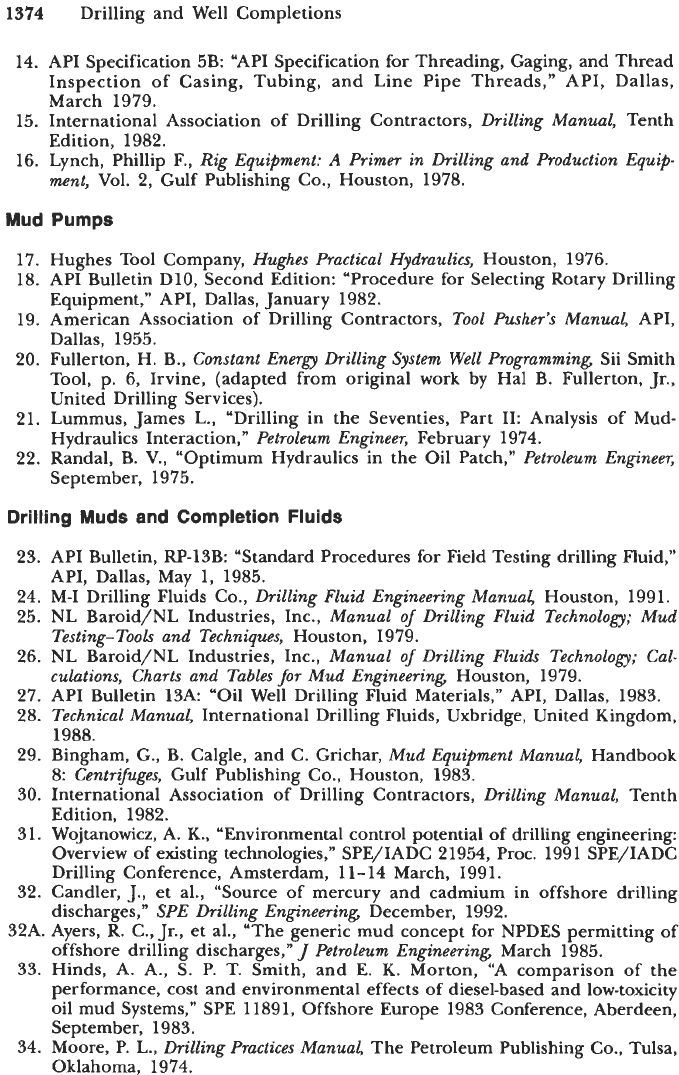
1374
Drilling and Well Completions
14.
API Specification
5B:
“API Specification for Threading, Gaging, and Thread
Inspection of Casing, Tubing, and Line Pipe Threads,” API, Dallas,
March
1979.
15.
International Association of Drilling Contractors,
Drilling Manual,
Tenth
Edition,
1982.
16.
Lynch, Phillip
F.,
Rig Equipment:
A
Primer in Drilling and Production Equip-
ment,
Vol.
2,
Gulf Publishing Co., Houston,
1978.
Mud Pumps
17.
Hughes Tool Company,
Hughes Practical Hydraulics,
Houston,
1976.
18.
API Bulletin
D10,
Second Edition: ”Procedure for Selecting Rotary Drilling
Equipment,” API, Dallas, January
1982.
19.
American Association of Drilling Contractors,
Tool Pusher’s Manual,
API,
Dallas,
1955.
20.
Fullerton, H. B.,
Constant Energy Drilling System Well Programming,
Sii Smith
Tool, p.
6,
Irvine, (adapted from original work by Hal
B.
Fullerton, Jr.,
United Drilling Services).
21.
Lummus,
James
L.,
“Drilling in the Seventies, Part 11: Analysis of Mud-
Hydraulics Interaction,”
Petroleum Engineer,
February
1974.
22.
Randal,
B.
V.,
“Optimum Hydraulics in the Oil Patch,”
Petroleum Engineer,
September,
1975.
Drilling Muds and Completion Fluids
23.
API Bulletin,
RP-1SB:
“Standard Procedures for Field Testing drilling Fluid,”
24.
M-I Drilling Fluids Co.,
Drilling Fluid Engineering Manual,
Houston,
1991.
25.
NL Baroid/NL Industries, Inc.,
Manual
of
Drilling Fluid Technology; Mud
26.
NL Baroid/NL Industries, Inc.,
Manual
of
Drilling Fluids Technology; Cal-
27.
API Bulletin
13A
”Oil Well Drilling Fluid Materials,” API, Dallas,
1983.
28.
Technical Manual,
International Drilling Fluids, Uxbridge, United Kingdom,
1988.
29.
Bingham, G.,
B.
Calgle, and C. Grichar,
Mud Equipment Manual,
Handbook
8:
Centrifuges,
Gulf Publishing Co., Houston,
1983.
30.
International Association of Drilling Contractors,
hilling Manual,
Tenth
Edition,
1982.
3
1.
Wojtanowicz, A. K., “Environmental control potential
of
drilling engineering:
Overview of existing technologies,” SPE/IADC
21954,
Proc.
1991
SPE/IADC
Drilling Conference, Amsterdam,
11-14
March,
1991.
32.
Candler,
J.,
et al., “Source
of
mercury and cadmium in offshore drilling
discharges,”
SPE Drilling Engimm‘ng,
December,
1992.
32A.
Ayers,
R.
C., Jr., et al., “The generic mud concept for NPDES permitting of
offshore drilling discharges,”
J
Petroleum Engineering,
March
1985.
33.
Hinds, A.
A.,
S.
P.
T. Smith, and
E.
K.
Morton,
“A
comparison of the
performance, cost and environmental effects of diesel-based and low-toxicity
oil mud Systems,” SPE
11891,
Offshore Europe
1983
Conference, Aberdeen,
September,
1983.
34.
Moore, P.
L.,
Drilling Practices Manual,
The Petroleum Publishing Co., Tulsa,
Oklahoma,
1974.
API, Dallas, May
1, 1985.
Testing-Took and Techniques,
Houston,
1979.
culations, Charts and Tables
for
Mud Engineering,
Houston,
1979.
